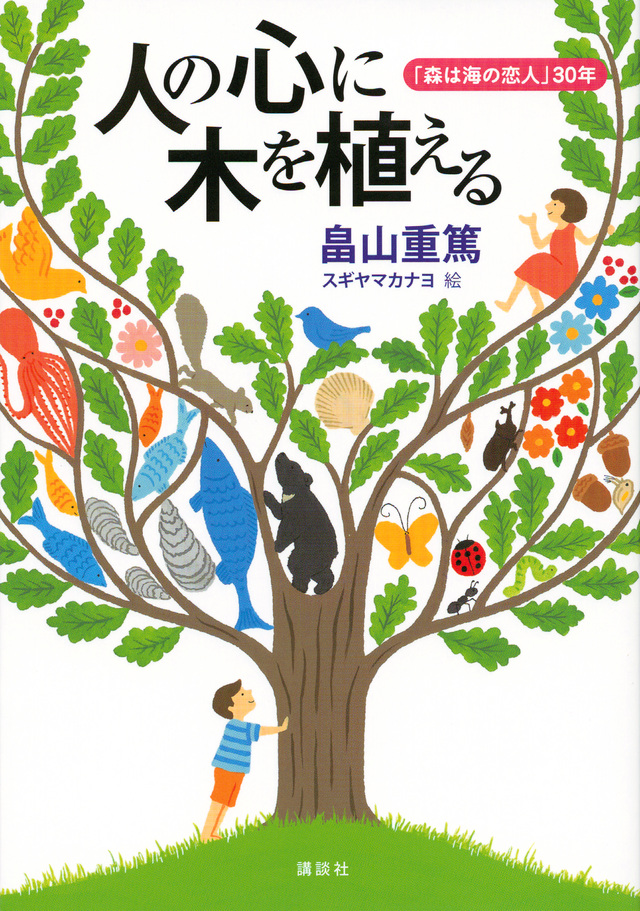A Fisherman’s Forest-Making - The Forest Is the Lover of the Sea

Shigeatsu introduces us to the Sanriku Rias of his youth, the seas and forests teeming with wildlife. Here he used to play, fish, and observe nature. He describes ways to catch eels. Eels only swim in clean waters and so are a useful indicator of the health of the rivers and the sea. These formative experiences in childhood sparked his curiosity and interest in the workings of nature. He experienced first-hand the great variety of wildlife in his local environment.
As an adult Shigeatsu took over the family oyster farm from his father. Oysters are grown from ‘seed oysters’. The seed oysters are attached to scallop shells which are strung in long lines from rafts in the bay. They require no feeding but occasionally must be moved to a new location so that the oysters have a fresh supply of phytoplankton. The family also raises scallops and nori seaweed. Business goes well thanks to Shigeatsu and his father’s enthusiasm for learning and honing their skills; however, in 1964, the year of the Tokyo Olympics, the bay becomes polluted. The nori dies off. The oyster harvests are poor. The oysters they do harvest are blood red. Shigeatsu thinks it might be the end of their family business.
Shigeatsu heads to France to learn more about aquaculture. He observes that the seas are teeming with a variety of aquatic life. He travels along the river and finds that the rivers are full of young eels. This means that the environment is very healthy. This is because of the rich, broad-leaf forests upstream. Nutrients from the leaf litter enter the rivers and these nutrients flow into the sea. He realizes that forests are the key to the problems he’s facing at home. He visits the mountain area above Kesennuma and decides to plant trees. He gathers his fellow fishermen and they hold a planting festival. This is the beginning of his treeplanting work. He is also tasked with coming up with a slogan for their activity. Shigeatsu asks a poet for help and she comes up with: “Mori wa umi no koibito (the forest is the lover of the sea)”
Shigeatsu looks for a researcher who can help him understand the science behind how the forests, rivers, and sea are connected. He learns that iron has an important role to play in providing food for phytoplankton. He also learns that a chemical compound called fulvic acid produced in the leaf litter makes a stable bond with iron particles in the rivers allowing iron to reach the sea in a form that phytoplankton can absorb. After conducting some tests, they discover 90% of the sea life in the depend on nutrients from the river.
Many of the children who live along the river and in the mountains never visit the sea. Shigeatsu takes a group on a study trip. He takes them out in his boat to see the oyster rafts and taste plankton. He explains that if the rivers are not clean, the oysters and other sea life don’t grow. The children enjoy the experience. After returning home they get their parents to cut down on using chemicals that might pollute the water.
Shigeatsu learns that the ‘rias’ in ‘Sanriku Rias’ is a Spanish word meaning a bay formed from a submerged river valley. Accompanied by his sons and an interpreter, he visits the Galicia region in Spain to learn more. He meets the head of the fishery co-op in A Coruña. Shigeatsu tells him about their tree-planting and their slogan “the forest is the lover of the sea”. They find out that in A Coruña they have a similar phrase: “the forest is the mother of the sea”. He finds out that Galicia used to be covered in oak and chestnut trees.
Since starting his tree-planting work under the banner of “the forest is the lover of the sea”, he has become well known, and has been featured in the newspaper and on television. Fishermen all over Japan have followed suit with their own planting events. Finally the connection between the mountain forests and the seas has become common knowledge. The number of people interested in the environment has grown. Shigeatsu finds out that eels have returned to the sea in Kesennuma for the first time in thirty years.
This book follows Shigeatsu on his journey as he discovers the importance of forests to the health of the sea. With this understanding begins his forest restoration and educational outreach work that eventually lead to successfully improving the sea environment. Shigeatsu’s curiosity and enthusiasm for learning comes through in the insights and anecdotes he shares along the way.
An illuminating example of how we are dependent on nature and how we can come together to protect and restore local environments and create community at the same time.
Published year : 2000
Pages : 176

